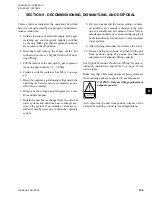
JOHNSON CONTROLS
165
FORM 155.30-ICOM2.EN.UL
ISSUE DATE: 12/21/2018
9
SECTION 9 - DECOMMISSIONING, DISMANTLING, AND DISPOSAL
Unless otherwise indicated, the operations described
below can be performed by any properly trained main-
tenance technician.
1. Isolate all sources of electrical supply to the unit,
including any control system supplies switched
by the unit. Make sure that all points of isolation
are secured in the off position.
2. Disconnect and remove the supply cables. For
connection points, see
3. Fill the interior of the unit with N
2
gas to pressur-
ize up to approximately 1.5 ~ 3 PSIG.
4. Prepare a suitable container. See
5. Drain the remaining solution and refrigerant in the
unit from each service valve as completely as pos-
sible into a container.
6. Dispose of the solution and refrigerant in a suit-
able and safe manner.
7. Isolate the unit heat exchanger from the external
water systems and drain the heat exchanger sec-
tion of the system. If no isolation valves are in-
stalled it may be necessary to drain the complete
system.
8. If glycol was used in the water system, or chemi-
cal additives are contained, dispose of the solu-
tion in a suitable and safe manner. Under NO cir-
cumstances should any system containing glycol
be drained directly into domestic waste or natural
water systems.
9. After draining, disconnect and remove the water.
10.
Remove fixing down bolts, and then lift the unit
from position, using the points provided and
equipment with adequate lifting capacity.
See
Signal Terminal Transition Wiring
for unit in-
stallation instructions, and
for
unit weights.
Make sure that while components are being removed,
the remaining parts are supported in a safe manner.
CAUTION: Only use lifting equipment of
adequate capacity.
After removing the unit from position, dispose of the
unit parts according to local laws and regulations.


































